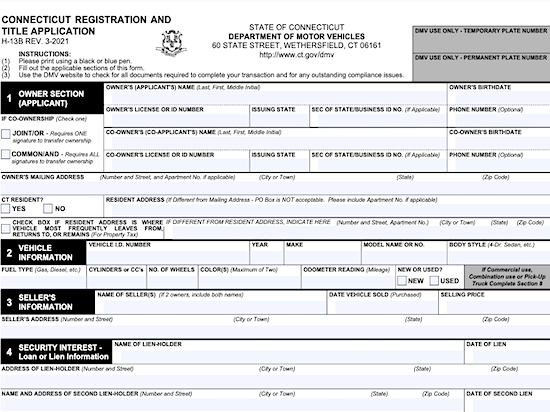
Southern New England is home to the state of Connecticut, with a little over 2.608 million drivers. In fact, one of the most congested highways in America runs from New Haven, CT to New York. And according to Edmunds, the Honda CR-V was the most popular car in the Constitution State this year.
Use eTags© to Quickly Complete Your DMV Service. Renewals, Title Transfers and More, All Online!
The fine print of CT DMV requirements
Connecticut drivers have no choice but to indulge in some of the caveats that come with car title and registration paperwork in CT. For example, the Connecticut DMV requires those with leased vehicles to get an original power of attorney from the leasing company. Also, you have to get an emissions test and possibly a VIN verification (only if your car is exempt from the emissions testing). The titling and registration paperwork gets more complex if your vehicle is out-of-state. Continue reading for an easy-to-use guide on how to transfer vehicle title register it in Connecticut.
Whether you’re buying new or used, the CT DMV recommends having a bill of sale
Title transfer and registration go together in Connecticut
First off, why the title transfer? If you recently bought a car, new or pre-owned or had one gifted to you, you need to transfer the ownership of that vehicle to you. So you must complete a title transfer application to legally become the car’s owner. Then you register the vehicle to be able to legally drive it on public roads. That registration certificate is attached to your license plates.

CT DMV Form H-13B
To transfer a vehicle title in Connecticut, you need to fill out the DMV’s form H-13B “Connecticut Registration and title application.” There’s an owner section also known as applicant, that’s you-the buyer-, a vehicle information section where you list the make, model, odometer reading, and list if it’s new or used. With online title and registration companies like eTags, you can do all of this paperwork online. You just follow through questions and prompts, to complete your title transfer and registration application.
For title and registration in Connecticut, you need proof of ID like your Connecticut driver’s license, as well as the original title signed to you by the seller. If the vehicle is 20 years and older, you don’t need a title. You can use the registration from the last owner. Car insurance is a must too! In the Constitution State, all registered vehicles must carry a minimum of liability insurance coverage.
To register a vehicle in Connecticut, you can’t have any outstanding property tax payments, parking tickets, or have had your registration suspended before

New to Connecticut, with an out-of-state vehicle
eTags online processes titles and registration for new residents to Connecticut. If you just moved and have out-of-state license plate(s), make sure you title and get CT tags. New Connecticut residents don’t have to pay sales tax if their car was registered in the same name in another state for at least 30 days before establishing Connecticut residency. Once you’re a CT resident, you have 90 days to transfer your vehicle registration. Remember, you need an emissions test or VIN check, depending on the model year of your vehicle. 2017 models and older need an emissions test done.
Connecticut Sales and Use Tax: 1991 model year and newer bought from private owners are subject to 6.35% or 7.75% for vehicles over $50,000









12 comments
I have given my son a loan against his car and want to put my name on his title as a lien holder. He recently moved to our home and so his address has been changed already on his license. Which form should I use and should he put his current address on the title or keep the original one that he has on the current title.
Your son can choose whichever address he wants as his mailing address. That will have no bearing on the adding the lien, even if you share the same address. You can use Florida DMV form HSMV 82139 to add a lien on the vehicle. You will need to turn in the title as well, after which you will receive a new title with lien on it.
I moved to CT from New York.
I have a loan from a bank and don’t have a title because the bank owns the car. How can I register the car in Connecticut?
You can find more detail about how to register your vehicle in CT, even thought the bank is in possession of the title, on this CT DMV page. They state: “If you have a lien or are leasing a vehicle, contact your lienholder or leasing company to notify them that Connecticut requires the original vehicle title to register a vehicle….If your lienholder provides a photocopy of the front and back of the title, you are eligible to receive a Courtesy Registration. Courtesy Registrations are valid for up to six months…“. Best of luck
i am buying out my leased vehicle. Please let me know what paperwork I will need to present at my appointment. thank you.
You’ll need proof of the lease buy-out, such as a bill of sale and proof of lien release which can either be the title with the lien release stamp on it or a separate lien release document. Keep in mind that you will need the title regardless of how the lien release is provided. Have your ID and proof of CT insurance ready as well.
i need to transfer my registration, title and plates from FL to CT. It sat in FL for a while and was delivered to me up here. I already got an emissions test and insurance for CT. New tires have been installed. How do I proceed?
You can go to any CT DMV office or certain dealerships licensed to register vehicles. You may also use eTags online CT transfer and registration services. No matter which option you choose, you will need to have the title for the vehicle, your ID, a completed inspection , and the signed application forms.
Additional resources from eTags.com
How do I transfer my registration from one car to another car.
Hello there, with etags online, here’s how you would proceed on this link. You’ll choose Connecticut (assuming that’s where you reside), transfer title as a service, but request transfer plate. Direct from our agents for more details: We only transfer a plate in conjunction with a title transfer. The plate must be valid (not expired) and in the customer’s name unless it’s a lease buyout. (then it would be in the leaseholder name) You’d get to this option by selecting transfer title and then prompted to choose an option for new or transfer plate.
I am leasing a car in Danbury. I am selling my old car. I want to transfer my old plates to the new car. How many days from the sale of my old car are the plates still good?
This article will give you all the details.